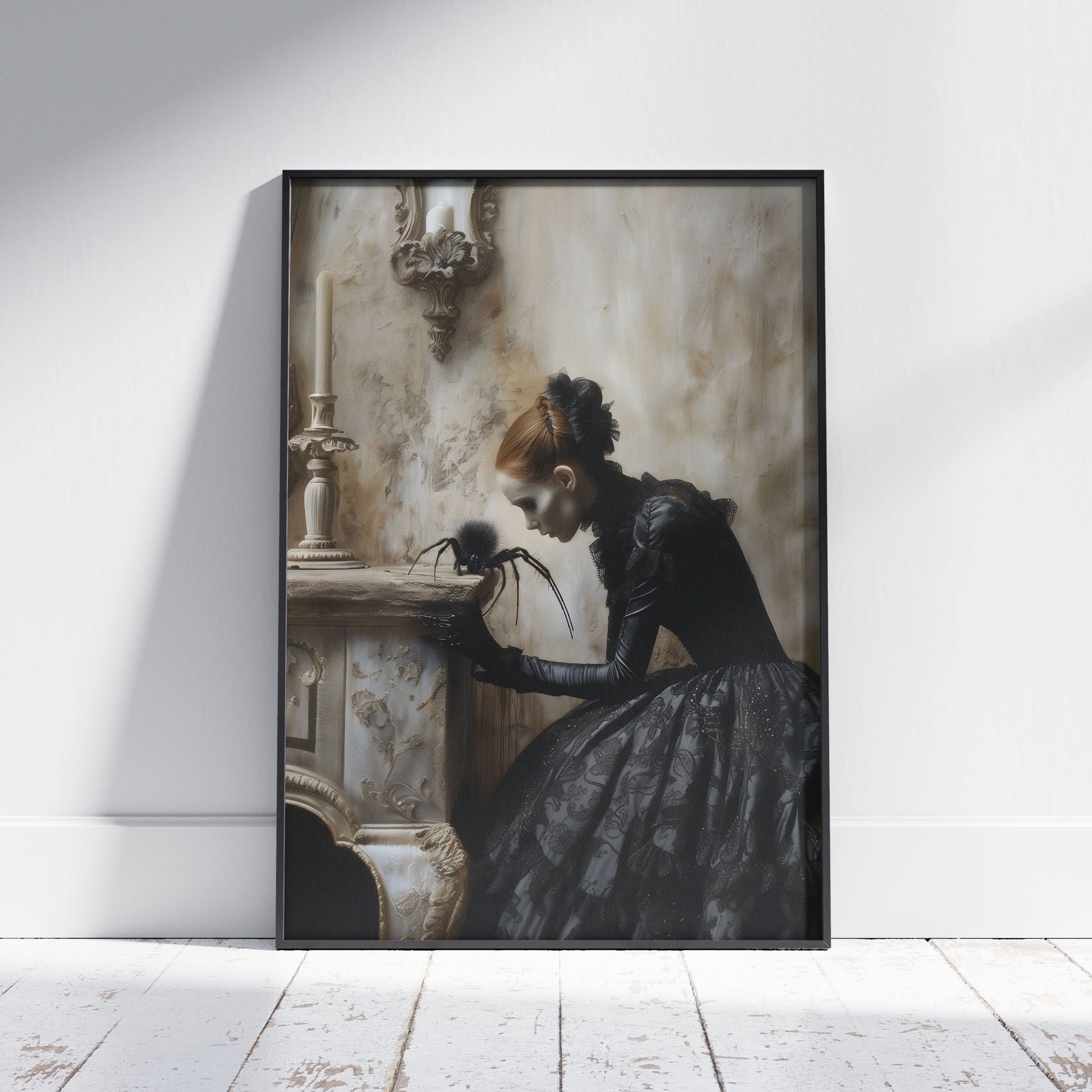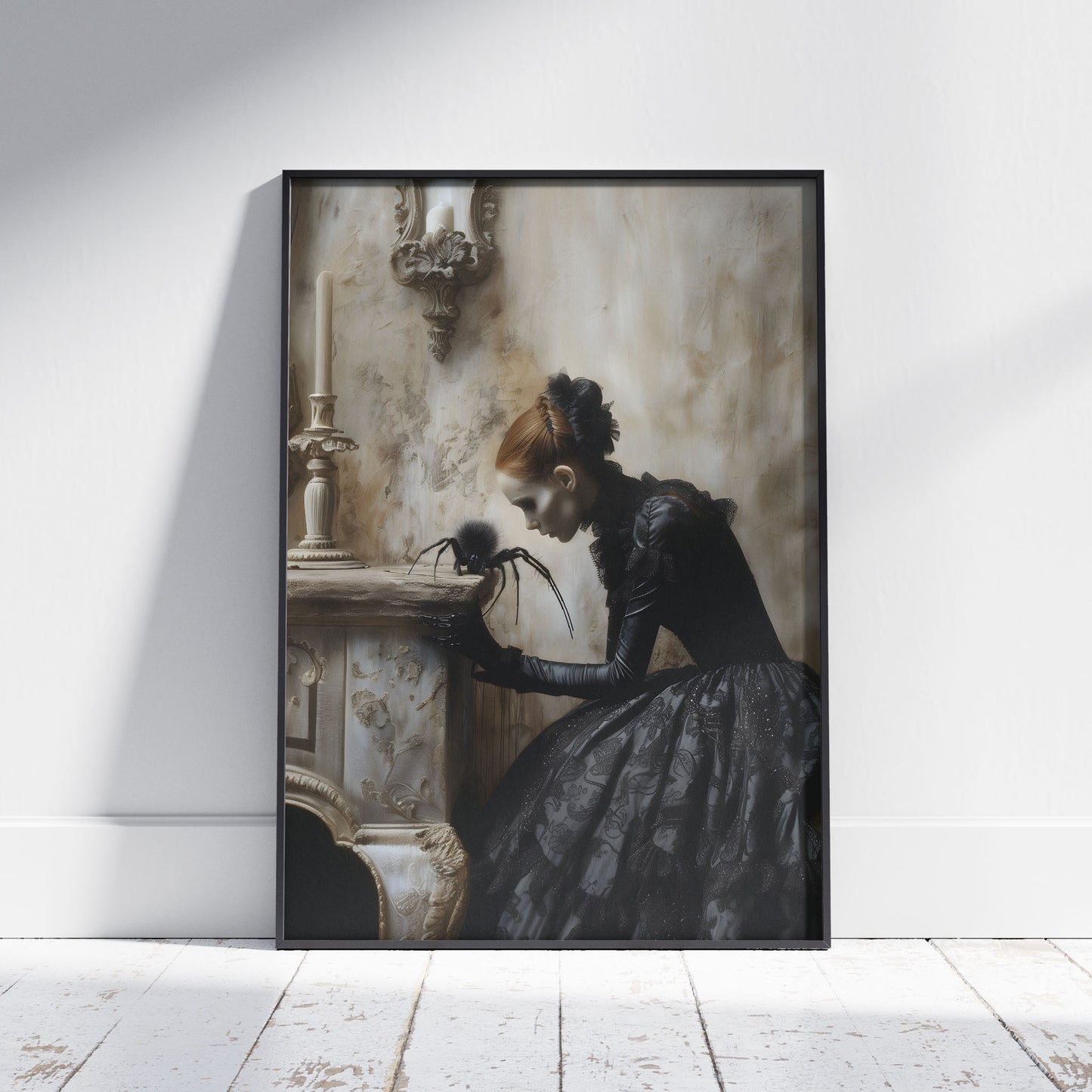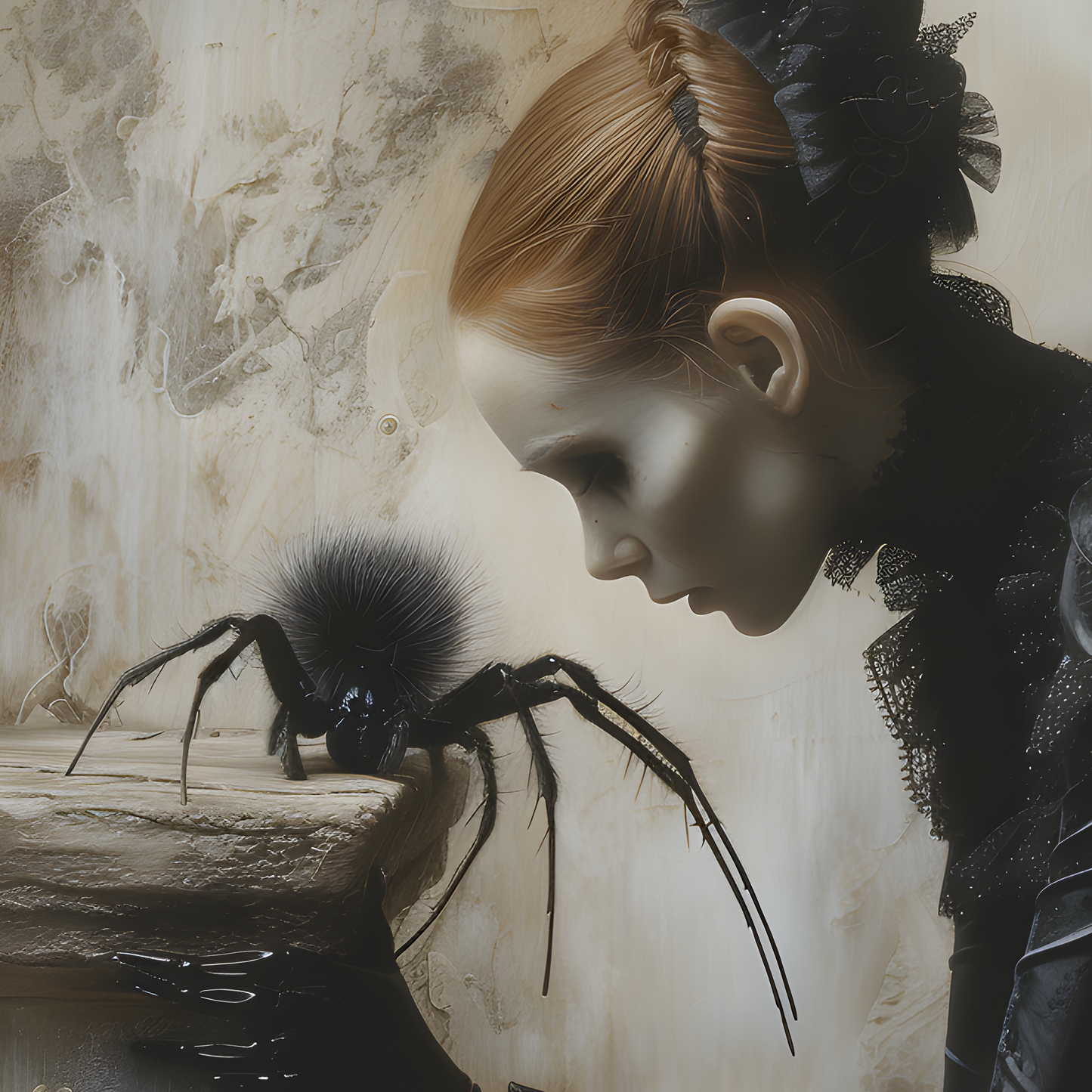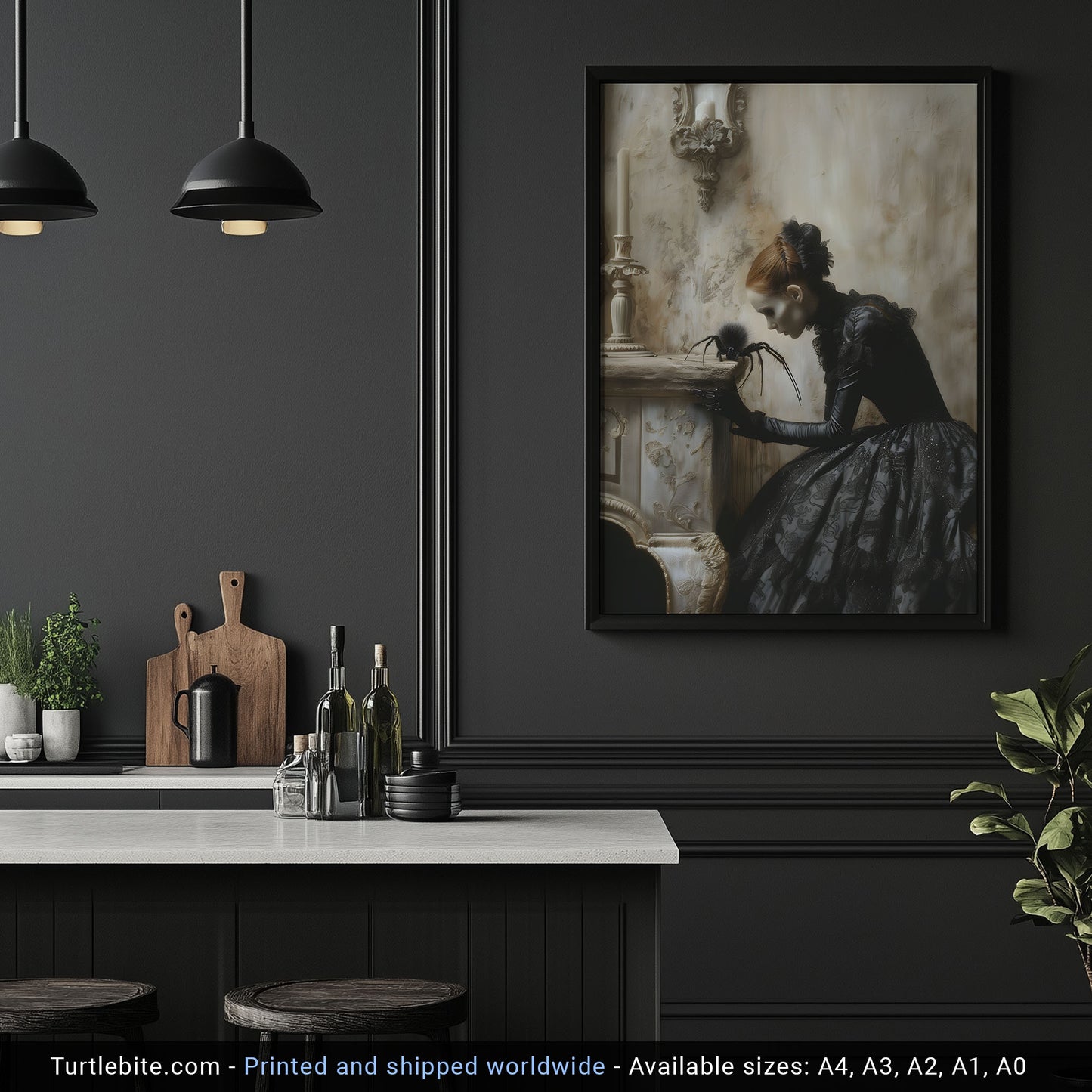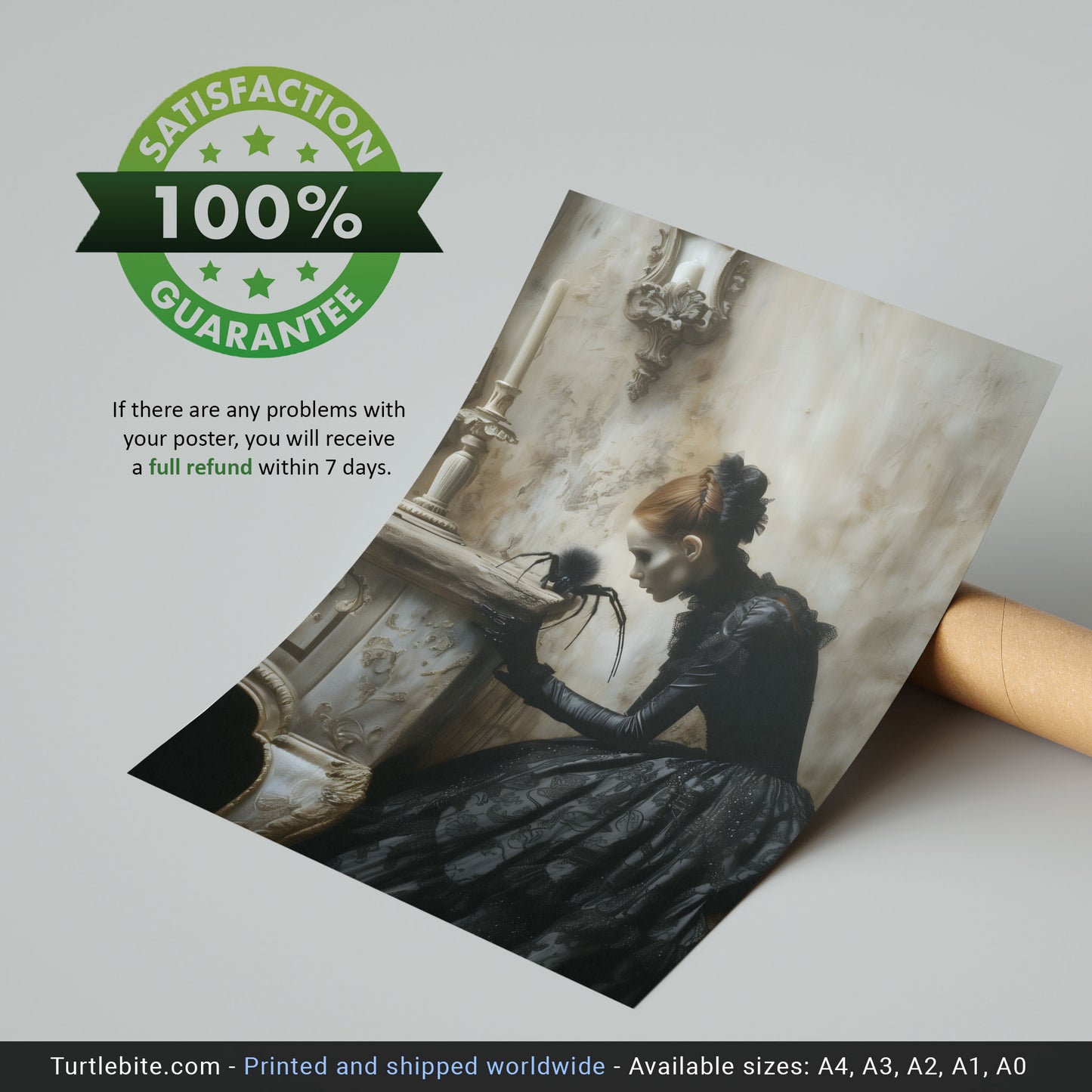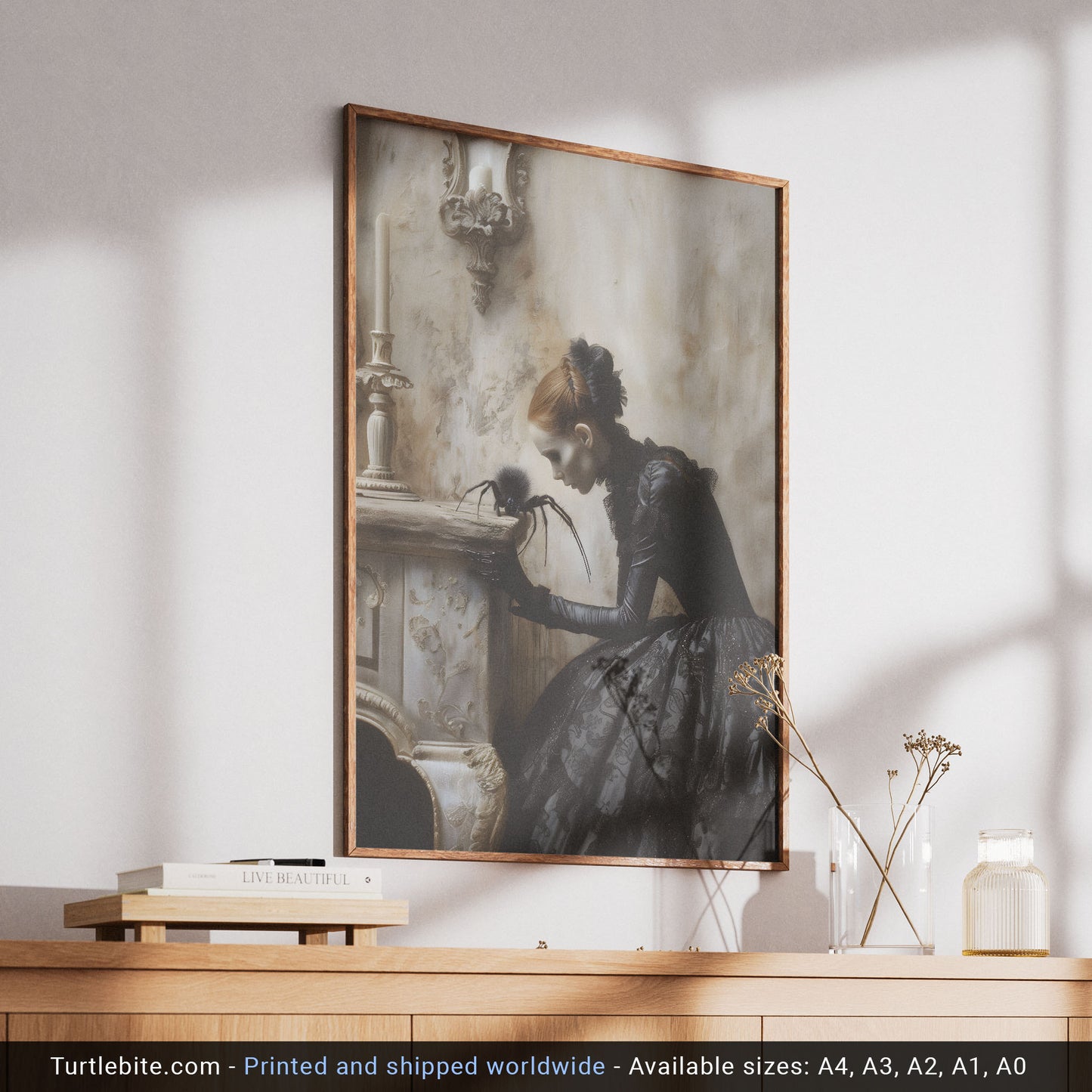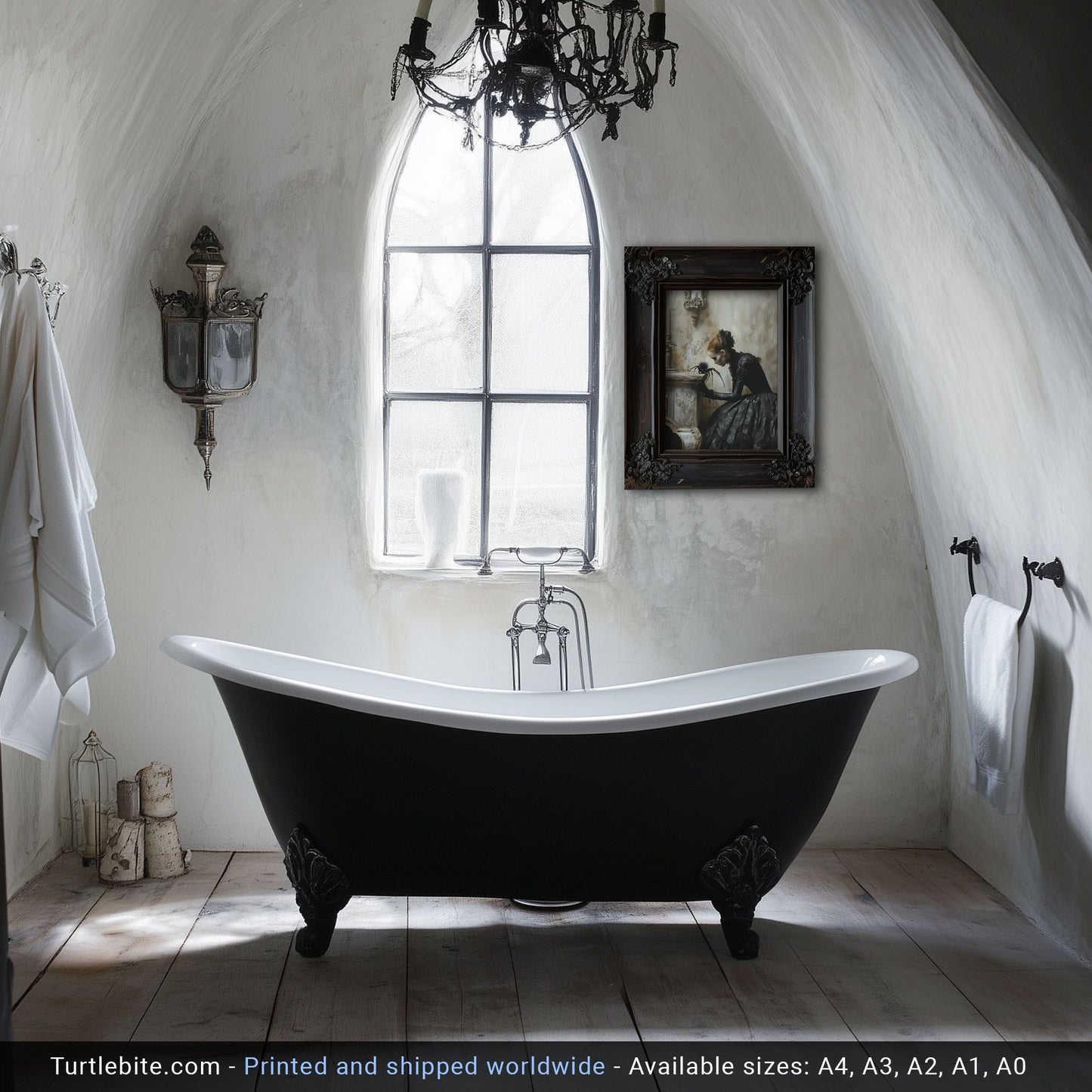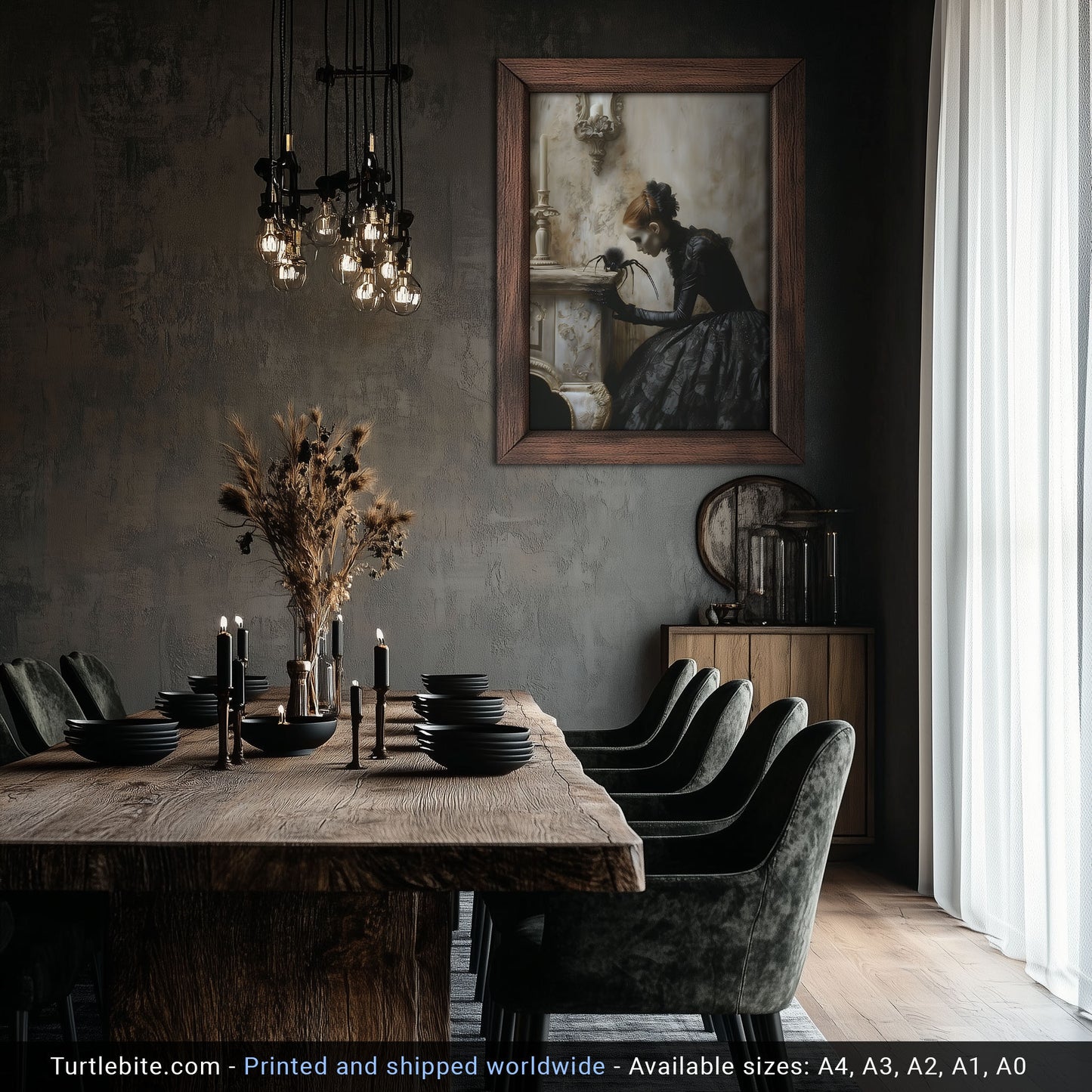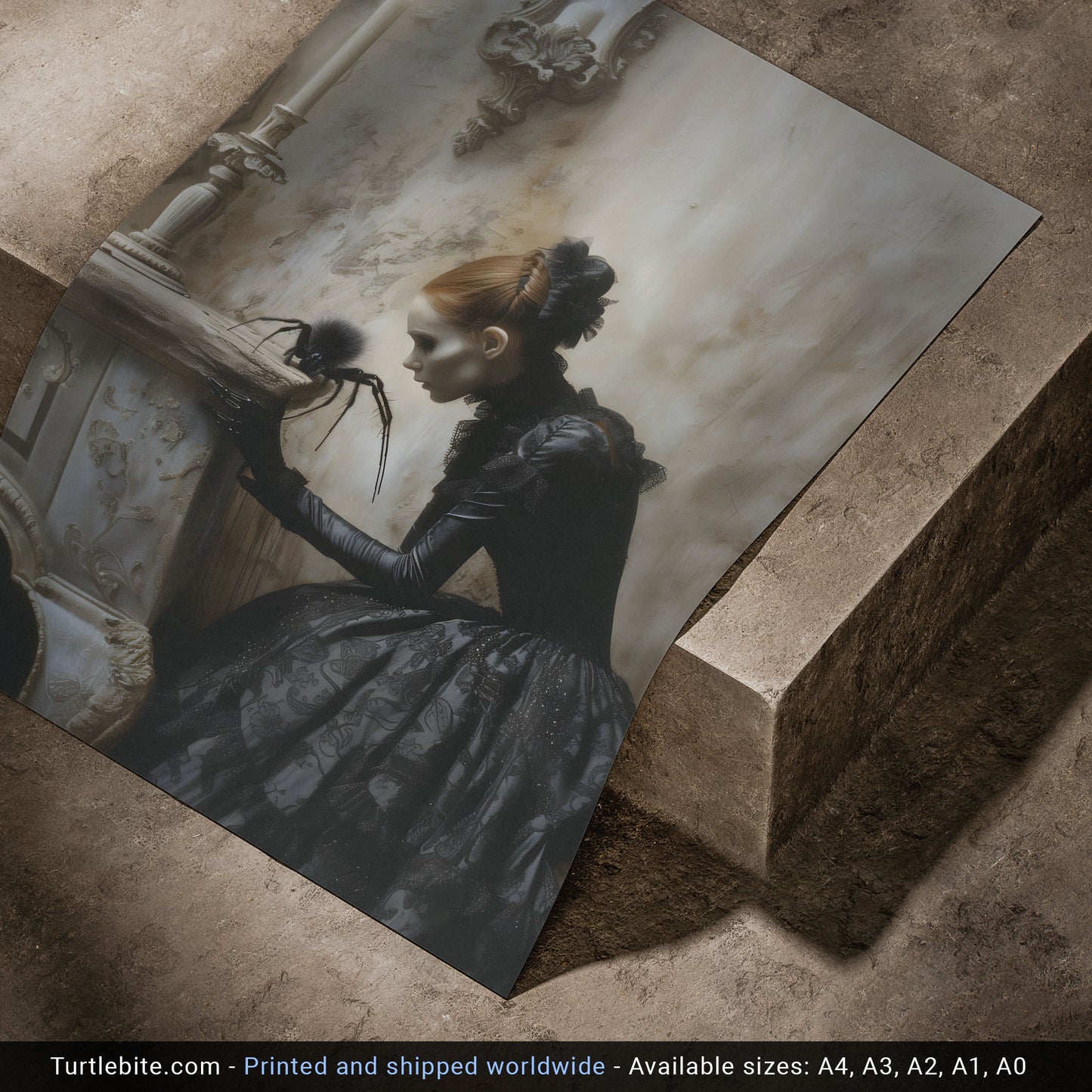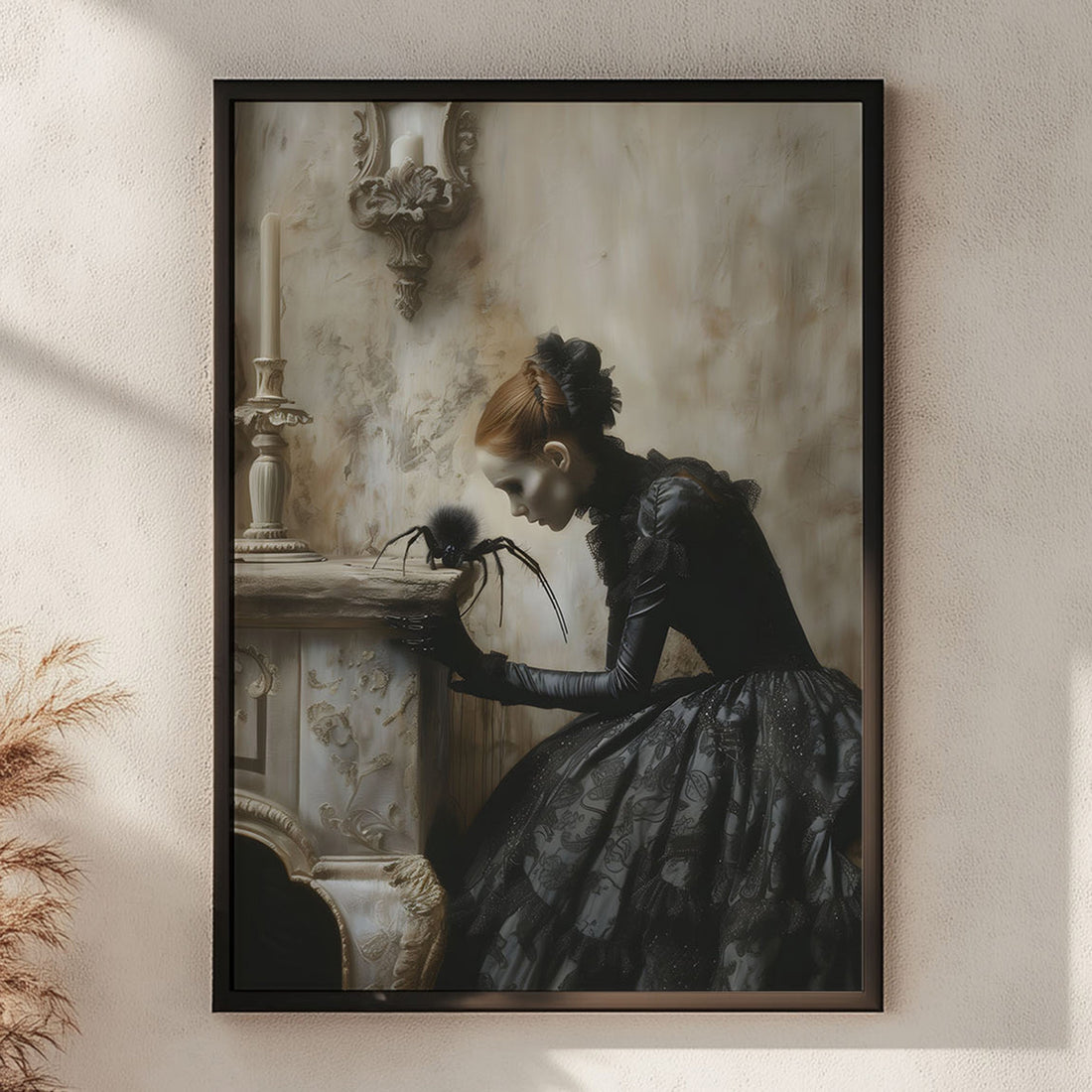
Gothic Elegance and Macabre Charm: A Visual Journey through Dark Beauty
ChristianShare
Gothic imagery has long fascinated viewers with its blend of beauty and morbidity, elegance and decay. The image in question offers a cinematic yet deeply intimate scene featuring a lone woman in a black Victorian gown, crouched by an ornate fireplace, reaching toward an unnervingly large spider. With Baroque elements, a melancholic atmosphere, and surrealist touches, the image becomes a silent narrative of restraint, fear, allure, and the sublime. This blog post dissects the photograph through compositional analysis, symbolic interpretation, stylistic evaluation, and its evocation of gothic tradition.
Composition and Framing
The composition is immediately arresting. The viewer’s eye is drawn to the woman, positioned to the right of center, subtly bowed forward in reverence or curiosity toward the black spider. The image follows a classic triangular balance - from the fireplace mantle, to the woman’s bent figure, and down to the ornate chair upon which she rests.
The elements are tightly framed, fostering a sense of claustrophobia and intimacy. The negative space created by the textured wall adds breathing room but also accentuates the subject's isolation. Every curve in the ornate décor, every fold in her gown, pulls us deeper into a story that’s haunting yet strangely elegant.
The symmetry of the surrounding objects - candle holders, carved moldings, and the heavy frame of the mirror - contrasts with the chaotic, spindly figure of the spider. This compositional dissonance enhances tension, crucial to the gothic mood.
Style and Texture
The textures in the image are lush and tactile - a feast for the senses. The woman’s black gown is adorned with fine lace, subtle embroidery, and tiered ruffles. Each fabric layer is carefully detailed, hinting at aristocratic richness but in a palette drained of life. Her gloves shine faintly, suggesting smooth leather, adding to her somber regality.
Meanwhile, the wall and fireplace appear distressed, with a worn patina of age - flaking paint, rough brush textures, and golden-brown staining that mimics the look of antique parchment or decayed wallpaper. This contrast - between the pristine elements of her attire and the degrading room around her - underlines the central gothic theme of beauty decaying into darkness.
The spider, with its surreal puffball body and unsettlingly long limbs, introduces a strange, almost dreamlike texture. It’s not a realistic spider - it’s a symbol, a metaphor, an object pulled from the subconscious. The fluff-like texture suggests softness, even playfulness, contrasted by its grotesque size and looming legs.
Lighting plays an essential role here too: soft and directional, it mimics natural candlelight. The highlights on the woman’s pale face and the glossy spider limbs are almost painterly, reminiscent of chiaroscuro from classical oil paintings, reinforcing the gothic romanticism that saturates this work.
Foreground & Subject
The primary subject, the woman, embodies gothic archetypes: the haunted noblewoman, the melancholic beauty, the mysterious femme fatale. Her posture - a gentle lean, head bowed slightly - evokes a silent dialogue. Is she curious, afraid, connected, or resigned? Her red hair, tightly pinned and crowned with a black hairpiece, becomes a vivid focal point amid the monochrome tones.
Her dress is not just attire - it’s character armor. The tightly cinched waist, puffed sleeves, and high collar all speak of restriction, control, and era-specific gender norms. Her identity seems shaped by the very fabric she wears. Yet her face, softly lit and vulnerable, hints at a longing to escape or connect - perhaps with the spider, perhaps with something deeper inside her.
The spider occupies a curious place in the composition. Though smaller than the woman, it holds equal visual weight. Its exaggerated size and soft texture defy natural realism. It seems too tender to be dangerous, too alien to be real - a product of fear and fascination. In gothic literature, spiders often symbolize patience, weaving, and unseen dangers. Here, it might represent an inner demon, a secret desire, or the lurking presence of death.
Placed on the fireplace mantle - a traditional symbol of warmth, safety, and family - the spider becomes an invader of the domestic sphere. The woman’s calm reaction challenges our expectations: she doesn’t recoil. Instead, she leans in, perhaps indicating a willingness to confront her fears or a fascination with danger.
Background and Setting
The setting is crucial to the image’s narrative. We find ourselves inside a richly adorned yet decaying Victorian room. The cream-colored wall, worn down and washed with brown and gold smears, recalls old oil paintings or the passage of time. There’s a melancholic beauty in the decay - where opulence has given way to erosion.
The fireplace, ornate and cream-toned, is carved with floral baroque flourishes. It's both a visual anchor and a metaphorical one. Traditionally a hearth suggests comfort and life, but here it has become a stage for confrontation between beauty and the grotesque.
On the mantle, two candlesticks and an elaborate mirror suggest a once-vibrant domesticity, now dulled. The mirror, however, shows no reflection. Whether due to the angle or intentional omission, its emptiness becomes symbolic - a portal denied, a gaze refused.
The entire room is hushed, almost sacred. It’s as though we’ve entered a chamber of secrets, preserved in wax and velvet. The lack of clutter, the monochromatic scheme, and the aged finishes make the viewer feel like a time traveler - peering into a frozen moment of psychological intensity.
Symbolism and Narrative Themes
This image doesn’t simply portray a woman and a spider - it tells a story of tension between vulnerability and power, life and decay, control and chaos.
The woman may represent someone caught between societal expectation (as symbolized by the dress and decorum) and inner transformation (embodied by the spider). The spider becomes a multifaceted symbol: it may represent suppressed desires, fears confronting her psyche, or even creativity and femininity - as spiders are weavers, creators.
Her posture suggests reverence rather than terror, hinting at acceptance. There is intimacy in her gaze, as if she’s come to terms with this darker aspect of herself. The spider might not be a threat but a revelation.
The choice of gothic style allows this scene to transcend literal interpretation. It becomes an allegory. The crumbling background speaks to decayed glory, the dress to past roles, the spider to a potential future - one not yet understood but not rejected either.
In literary terms, this could be the visual echo of a Poe poem or a Brontë novel: the feminine mind caught in a storm of silence, elegance, and eerie introspection.
Emotional Tone and Viewer Response
There’s an eerie calm that pervades this image. It neither shocks nor soothes, but lingers like a soft whisper. The emotional palette is complex: there’s fascination, mourning, curiosity, and a tinge of dread. The woman’s composure invites us to feel with her rather than fear for her.
Viewers may experience a sense of voyeurism - as though they’re intruding on a moment of private communion. Others may interpret the scene as a confrontation with mortality or a metaphor for embracing one’s shadow self.
The emotional ambiguity allows each viewer to project their own psyche into the scene, creating a deeply personal engagement with the art.
Conclusion
This gothic portrait weaves elegance, symbolism, and surrealism into a moment of quiet intensity. With its lush textures, baroque elements, and haunting atmosphere, the image is a meditation on the duality of beauty and fear. The interaction between woman and spider becomes a visual poem - one of restraint and revelation, tradition and transformation. As we peer into this dim, richly constructed world, we’re reminded that darkness isn’t always to be fled, but sometimes embraced - with silk gloves and open eyes.

